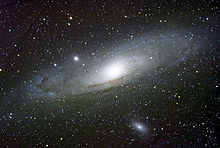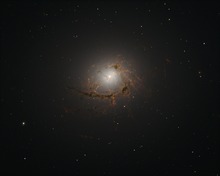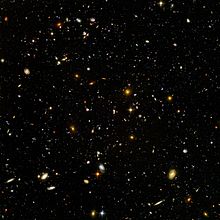Galaxy
![]()
The title of this article is ambiguous. For other meanings, see Galaxy (disambiguation).
A galaxy is a gravitationally bound large collection of stars, planetary systems, gas nebulae, dust clouds, dark matter, and other astronomical objects with a total mass of typically 109 to 1013 solar masses (M☉). Their diameter can be several hundred thousand light-years. While large galaxies often form the structure of spirals, dwarf galaxies are mostly of irregular type. In addition, other types and shapes exist. The Milky Way, home galaxy of the solar system, is a barred spiral of about 1.5 trillion M☉ with about 250 billion stars. From Earth, more than 50 billion galaxies can be observed with current technology. Since 2016, research has assumed that there are about one trillion galaxies in the observable universe.
The term derives from the synonymous ancient Greek γαλαξίας galaxías and goes back to an ancient legend, according to which it is the splashed milk (γάλα gála) of the goddess Hera, when she wanted to breastfeed Heracles. In German, galaxy (singular) refers specifically to the Milky Way. In English (generally galaxy, for the Milky Way in addition to the Milky Way Galaxy or the Milky Way also briefly the Galaxy) there is a similar distinction. Alexander von Humboldt used the term "world island".

The Andromeda galaxy is the closest spiral galaxy to the Milky Way
General
Galaxies vary greatly in appearance (morphology), size and composition. The Milky Way has a diameter of up to 200,000 light years and thus belongs to the larger galaxies. Its nearest neighbour galaxy of comparable size is the Andromeda Galaxy at a distance of about 2.5 million light years. Together with other galaxies of smaller mass, both galaxies form the Local Group. Galaxies often appear in groups or clusters with up to several thousand members.

Dust filament in the elliptical galaxy NGC 4696

The Ultra-Deep-Field shows about 10,000 galaxies in a thirteen millionth part of the sky
Exploration history
Before the power of astronomical telescopes was sufficient to resolve distant galaxies into individual stars, they appeared as "nebulae". For a long time it was unclear whether these "spiral nebulae" belonged to the Galaxy or formed their own star systems. Immanuel Kant already suspected milky way-like star systems in the "nebulous stars", and in 1923 Edwin Hubble succeeded in clarifying this question. He determined the distance to the Andromeda Nebula and found that it is much too far away to belong to the Milky Way, i.e. it represents a galaxy of its own.
Questions and Answers
Q: What is a galaxy?
A: A galaxy is a group of many stars, gas, dust and dark matter held together by gravity.
Q: Where does the word 'galaxy' come from?
A: The name 'galaxy' comes from the Greek word galaxia meaning milky, which is a reference to our own galaxy, the Milky Way.
Q: How are galaxies held together?
A: Galaxies are held together against the general expansion of the universe by gravity. Expansion of the universe takes place between groups of galaxies rather than inside them.
Q: What types of galaxies exist?
A: There are various types of galaxies including elliptical, spiral and lenticular galaxies with or without bars as well as irregular galaxies.
Q: How many stars are in an estimated 1x1024 galaxies?
A: An estimated 1x1024 galaxies contain more stars than all the grains of sand on planet Earth.
Q: How many observable universes exist? A: The observable Universe contains more than 2 trillion (1012) galaxies.
Search within the encyclopedia